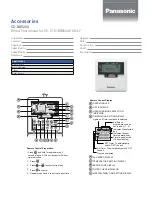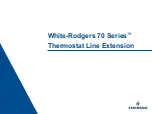
Option 10—Dual Fuel Equipment
All dual fuel installations must be equipped with a high
pressure switch to turn off compressor under a high indoor
coil pressure condition.
The high pressure switch protects compressor and indoor coil from
overpressure which would occur if a failure or wiring error
resulted in the heat pump and furnace operating at the same time.
High Pressure Switch Kit includes required switch and instructions
for proper operation. For all dual fuel installations, outdoor
temperature sensor must be attached. If not, E3 error message will
appear. See "Error Codes."
This option requires prior selection of heat pump (DIP switch
1—ON), and must be selected in dual fuel installations. It prevents
simultaneous operation of both furnace and heat pump, and
prevents direct transition from heat pump to furnace operation.
When system is dual fuel (heat pump and furnace), set to ON.
When system contains fan coil, set to OF. Factory default is OF
(off).
TO SELECT:
1. Enter configuration mode if not already there. See Step 4 "To
Enter Configuration Mode." Use up and down buttons to make
small (now flashing) display indicate 10.
2. Press SET TIME/TEMP button once to flash large display.
3. Use up or down buttons to alternate between OF and ON on
large display. Factory default is OF.
4. Press SET TIME/TEMP button again to flash upper small
display for selection of another option, or press END to exit
configuration mode.
Option 11—Balance Point Setting
This option is for dual fuel installations only. It requires prior
selection of heat pump (DIP switch 1 -- ON) and dual fuel
equipment (Option 10 -- ON). It allows selection of an outdoor
temperature of 5
o
F. through 55
o
F. (or equivalent values in C.), or
OF (off). Heat pump is prevented from operating for outdoor
temperatures below selected temperature. If OF (off) is selected,
heat pump operation is allowed at all outdoor temperatures.
Factory default is OF (off). This setting can only be equal to or
below the setting choice made for Option 8. Moving the setting
higher may ’push’ Option 8 setting upward.
If the outdoor temperature is above the "balance point setting", the
heat pump will energize first to try to satisfy the indoor tempera-
ture demand. If the heat pump does not make a sufficient
improvement within a reasonable time period (i.e. 15 minutes),
then the gas furnace will come on to satisfy the indoor temperature
demand. If the outdoor temperature is below the "balance point
setting" the heat pump will not be allowed to operate (i.e. locked
out), and the gas furnace will be used to satisfy the indoor
temperature.
There are three separate concepts which are related to selecting the
final "balance point setting". Read each of the following carefully
to determine the best "balance point setting" in a dual fuel
installation:
CAPACITY BALANCE TEMPERATURE:
This is the point where the heat pump cannot provide sufficient
capacity to keep up with the indoor temperature demand because
of declining outdoor temperature. At or below this point, the
furnace is needed to maintain proper indoor temperature.
ECONOMIC BALANCE TEMPERATURE:
Above this point, the heat pump is the most cost efficient to
operate, and below this point, the furnace is the most cost efficient
to operate. This can be somewhat complicated to determine and it
involves knowing the cost of gas and electricity, as well as the
efficiency of the furnace and heat pump. For the most economical
operation, the heat pump should operate above this temperature
(assuming it has sufficient capacity), and the furnace should
operate below this temperature.
COMFORT BALANCE TEMPERATURE:
When the heat pump is operating below this point, the indoor
supply air feels uncomfortable (i.e. too cool). This is purely
subjective and will depend on the homeowner’s idea of comfort.
Below this temperature, the gas furnace should operate in order to
satisfy the desire of indoor comfort.
TO SELECT:
1. Enter configuration mode if not already there. See Step 4 "To
Enter Configuration Mode." Use up and down buttons to make
small (now flashing) display indicate 11.
2. Press SET TIME/TEMP button once to flash large display.
3. Use up or down buttons to move between OF, 5, 10, 15, 20,
25, 30, 35, 40, 45, 50, or 55 on large display. Factory default
is OF.
4. Press SET TIME/TEMP button again to flash upper small
display for selection of another option, or press END to exit
configuration mode.
Option 12—Defrost Heat Select
This option allows installer to select the amount of heat provided
by Thermidistat Control during a heat pump defrost cycle. This can
be very helpful in maintaining a comfortable leaving air tempera-
ture during defrost. The Thermidistat Control senses when defrost
is in progress by monitoring voltage placed on the O line by the
heat pump while defrosting. It responds by turning on selected
combination of W1 and W2 during defrost. Note that this is very
different from the operation of an ordinary thermostat, which
cannot sense defrost in progress and only turns on its W outputs in
response to a temperature demand. Combinations of W1 and W2
are selected via the following:
The selection procedure is given below. If 0 is selected, operation
is like that of an ordinary thermostat, and a wire is required
between W2 of outdoor unit and a selected W on indoor unit.
When selection 1, 2, or 3 is made, no wire should be connected
from outdoor W2 because this connection may override selection
made. Obviously the heater must be in 2 sections, and fan coil
jumper must be removed between W1 and W2 for there to be a
difference between selections 1, 2, and 3. For most heaters, W1 is
lower wattage heater, and W2 is higher, although some have equal
elements for W1 and W2. Consult fan coil/heater combination for
the actual wattage connected to each of W1 and W2.
In dual fuel applications, above selection choices apply and can be
used to select low or high heat if furnace is 2 stage. W1 will
produce low heat. W1 and W2 together produce high heat. This
option provides no value with single-stage furnaces because only
1 value of heat is available.
The selection choices guarantee selected outputs will be on during
defrost. If room temperature demand requires additional heat, it
Table 1—W1 / W2 Outputs
SELECTION
DEFINITION
0
Neither W1 or W2 is turned on.
This is factory default.
1
Only W1 is turned on.
2
Both W1 and W2 turned on.
3
Only W2 turned on (available
only if 3-stage heat is selected).
5






























